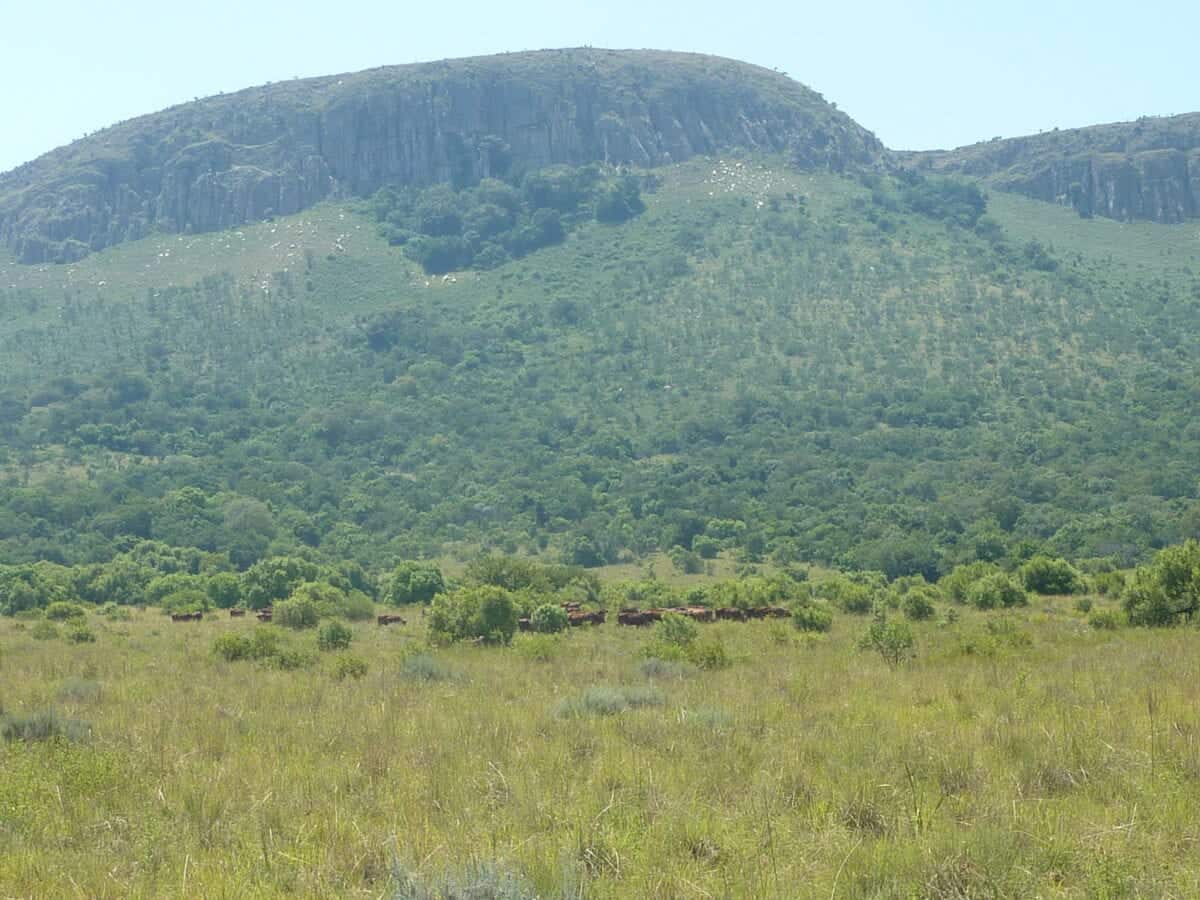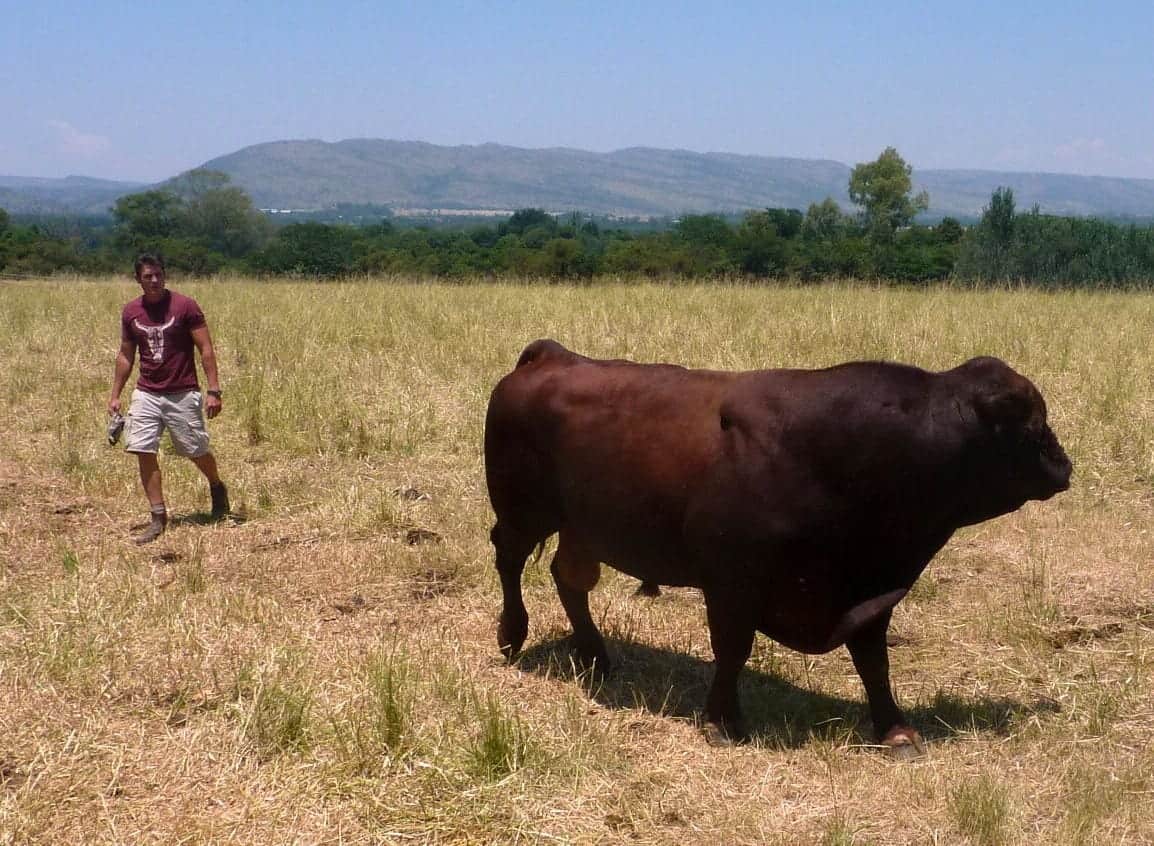Red Poll in South Africa
Oliver and Kate Paul had the fortune of visiting the Oostermoed herd in Gauteng, RSA, by kind invitation of Johan Oosthuizen and his son-in-law, Elma Steenkamp. Johan has invested in Red Polls following fond memories of a small herd his father had many years back. He is now finding returns for his business to be good, and improving.
The challenges of beef farming in South Africa can be acute as well as varied and different from the UK. Temperature, water, grass species, ticks, predators and more, would give the average Brit many sleepless nights. The weather determines their regime with hot wet summers (October to March) and dry winters that can be cold at night and suffer from pastureland becoming burnt-off.
Johan’s team operates around a single calving and aim to finish in under a year either on-farm or by selling on after weaning to a feedlot. Cows go to the bull in November and December with mature cows getting 3 months and heifers 4 months, and they aim to have an upward condition rating (3.5 going on 4) prior to bulling to optimise fertility. A manual PD follows 6 weeks after the bull is removed and barren cows would get a single second chance. However, recently 7 / 8 year old bulls have achieved 100% strike rate when running with c.30 cows. Calving has to happen towards the end of the winter, down near the farmstead to avoid predators and so mother and calf get close observation in the first few days. Bull calves are kept whole. Calves are then weaned before the end of April at just over 6 months and to avoid cows nurturing during the following lean winter months.
The South African Stud Book supports all breeds and maintains definitions and standards to allow breed performance to be assessed. Registration is around R60 (£3.40) per head and allows pedigree and growth rate data to be recorded centrally. Both cow and calf have to be weighed at birth and then the Oostermoed herd is now achieving 200kg at 6 months (weaning) and 400kg in under 12 months, when fat stock is slaughtered. Weaning weights were closer to 150kg a few years ago but improved nutrition has increased early growth rates by 30+%. The herd is often run in mobs of up to 120 cows together with 4 bulls. After the conception, cows typically form one group. The herd gaze mainly on permanent (native) grass during summer and temporarily in the winter with additional protein provided in the winter via a mix with milled maize corn. Salt licks with additional P are needed particularly in the summer.
Ticks are their number one enemy particularly having taken on new ground recently where there had been no tick management. They are battling to break cycles, reduce treatments whilst balancing the effectiveness of different drugs and encouraging as much auto-immunity as possible. Certain tick species can kill a cow within days and differing parasite problems arise in tall grass and in grasses that form a thick thatch. Ticks, along with occasional problems with flies, mites, liver fluke and the risk of eye infections from tall grass, means that preventive drugs often have to be administered once a month in the summer, as well as once a winter.
It must be noted that the problems exist for all breeds and herein many of the virtues of the Red Poll become apparent. Johan also runs the traditional Bonsmara cattle on the boerdery; developing synergies with the breeds and benchmarking performance. The Bonsmara is a sandy to rust coloured beast, polled and of similar size but with thicker skin (guarding against thorns), lower milk quality and a varying temperament. The deep red colour of the Red Poll is in high demand along with milk qualities and the Red Poll frame size; leading to enquiries about grading Red Poll sires into some Bonsmara herds. Elma has also recorded crossbred stock with greater growth rates than the pure bred Bonsmara or the pure Red Poll. They have only ever had one identifiable case of mastitis in Red Polls and the thinner hides of the Red Poll compared to the Bonsmara helps in the heat and also with the number of needles required for vaccination! All cows seen had four clear quarters in the udder and no problem of bulbous teats, which can occur in the Bonsmara. The good Red Poll temperament clearly provides an advantage with the level of handling required and it was interesting to hear that the breed was the only one to have stalls at the national agricultural show, Nampo, with gates open to the public.
The principle constraint to Johan’s plans is the Red Poll gene pool in RSA. This lead him to organise c.150 embryos to be exported from the Kirton and Euston herds in the UK, after being paired with Fedw Tomos and Fedw Stig. Elma has now placed some 45 embryos into Bonsmara surrogates with a success rate of c.60% compared an anticipated success rate of 30-50%. This has produced a range of strong heifer calves (with truer breed type characteristics particularly straighter backs than their original home herd) and a few bull calves. There is a local market demand for Red Poll stock bulls but Johan is set getting Elmer to build numbers before supplying the livestock market.
Concerning fat stock, Johan tasks Elma to produce the best return on low input costs as possible, in a tight timeframe. Heifers go to the bull at 14 months / 450kg. The calving periodicity is 370 – 380 days (compared to 405 days with the Bonsmara) and they want a top grade carcasses for the mainstream market with some fat … all quite different from the artisanal market of the UK! Deadweight prices are currently R30 to R38 / kg (£1.70 to £2.15 / kg) with liveweight prices at around R24 / kg (£1.40 / kg). They have been consistently achieving 56% carcass yield and abattoirs will do home kills solely in lieu of the fifth quarter. South Africa has no cattle traceability system.
Plans for the Oostermoed herd are to build numbers, gather statistics to prove the breed qualities and generate interest in the South African livestock (pure or crossbred) market, and a potential joint venture butchery for direct sales. Johan Oosthuizen and his family were fantastically hospitable and his son-in-law Elma Steenkamp is a real enthusiast for the breed. So if you’re in that nek of the veld, a stay at the guesthouse on the boerdery is essential – www.rustig.co.za


